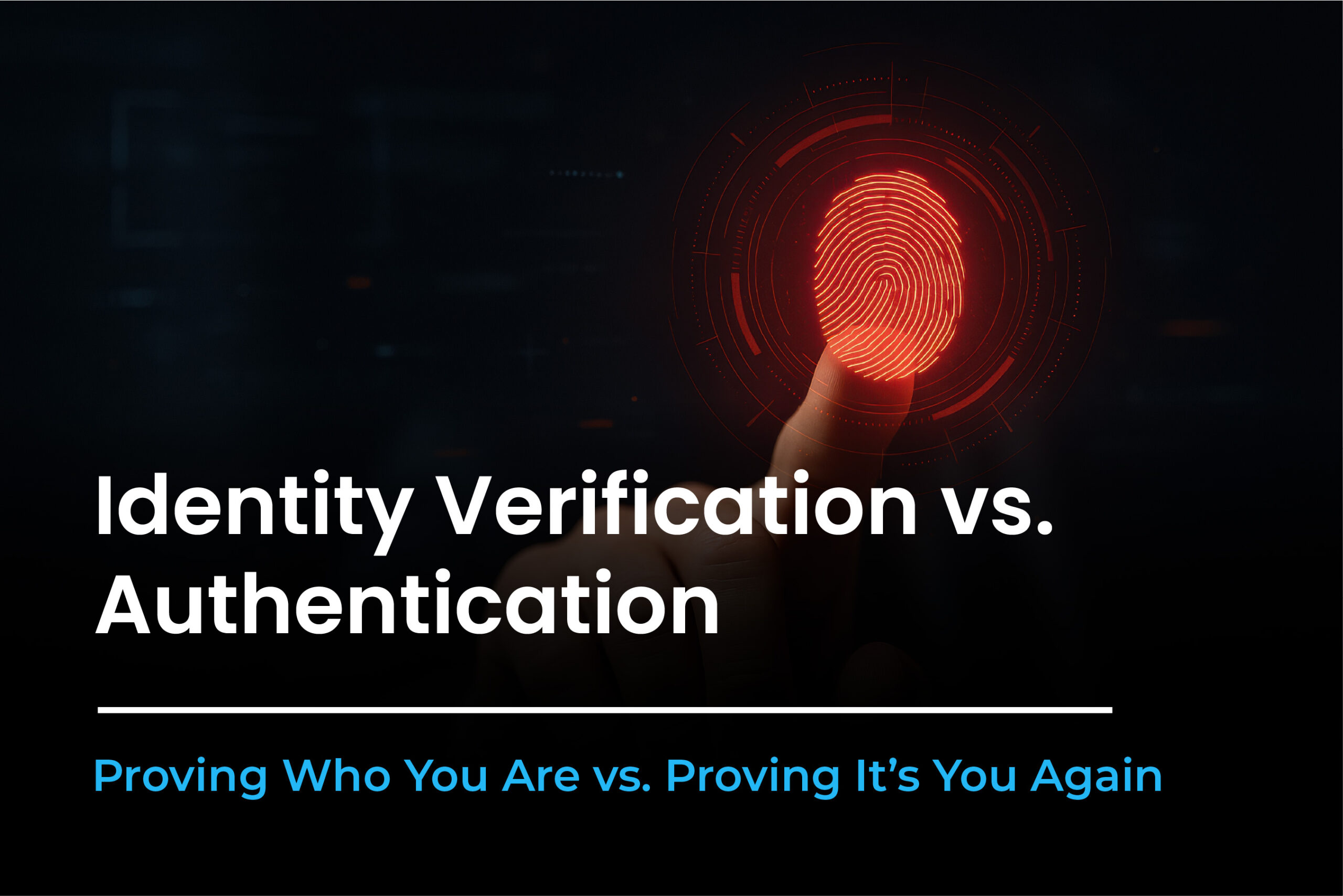Identity Verification vs. Authentication: Understanding the Difference

“We already have 2FA, so we’re covered on identity, right?” We often hear this from CISOs, IT managers, and startup founders. We must always take a moment to clarify that identity verification vs authentication is more than just semantic contrasts. The difference has significant effects on your user experience, security, and compliance.
Let’s define these phrases, explain their differences, and explain why, in 2025, your business cannot afford to use them interchangeably.
What Is Identity Verification?
What is identity verification? Simply put, it’s the process of confirming that someone is who they claim to be.
It often involves database comparisons, the use of biometric scans to match faces to IDs, or the verification of official records such as passports or driver’s licenses. This provides the foundation for high-stakes services including banking, insurance, healthcare, and remote work.
We like to think of identity verification as the front desk demanding to see someone’s ID when they walk into your office and claim to be John Doe. Anyone could pose as someone else without it.
What is Authentication?
Now, what is identity authentication? Authentication is what happens after verification. It’s the process of confirming that a previously verified identity is now accessing a system or account. Think of Passwords, PINs, OTPs, Passkeys, and Biometrics.
This is ongoing. Every login, every session, every transaction; authentication checks that the same John Doe who verified his identity earlier is the one logging in now.
So, authentication vs verification is essentially:
• Verification = “Who are you?”
• Authentication = “Are you still the same person I verified earlier?”
Identity Verification vs. Authentication: Similarities
Despite having distinct functions, identity verification and authentication are complementary components of a secure access strategy because they share a number of essential characteristics. To ensure that only the right individuals have access to sensitive information, systems, or services, both procedures are vital parts of identification in cybersecurity.
These both start by establishing trust using user credentials or identifiers, such as a Passkey, Biometric information, or a government-issued ID. The objective in both situations is to reduce the risk of fraud, account takeover, or impersonation.
Second, authentication and verification both benefit from layered security. For example, document scanning combined with biometric matching during onboarding (verification) can work in tandem with multi-factor authentication (authentication) to create a continuous trust loop.
Third, these processes share a dependency on reliable technology and secure data handling practices. Poor data integrity or insecure storage can undermine both stages. Whether you’re running identity proofing and identity verification checks or authenticating a returning user, accuracy and data protection are equally critical.
Lastly, both offer a better user experience when applied with minimal friction. These days, adaptive authentication systems and verification identification tools operate in the background, enabling organizations to maintain robust security without annoying authorized users.
To put it briefly, identity verification and authentication are powerful when paired because of their similarities; the more robust your initial verification is, the more successful your authentication will be over time.
Identity Verification vs Authentication: The Core Differences
Here’s where it often gets muddled especially in identification in computer security settings. So, let’s unpack it clearly:
- Timing and Context
- Verification happens at the beginning of a relationship (sign-up, account creation, KYC).
- Authentication happens every time someone tries to access a resource (login, transaction approval, session management).
- Purpose
- Verification proves identity.
- Authentication proves continuity of identity.
- Methods
While both use credentials, the types and purposes vary. This leads us to…
Common Identity Verification and Authentication Methods
Here’s a closer look at the identity verification methods and authentication techniques enterprises are using today:
Identity Verification Methods:
- Document scanning (e.g., driver’s license, passport)
- Biometric matching (facial recognition, fingerprint)
- Liveness detection (to prevent spoofing)
- Database cross-checks (e.g., SSN, phone number lookups)
- Verify documents via OCR and AI models.
- Online identity verification methods like selfie-video match
- Remote notarization (especially in finance or real estate)
- Accurate identity verification methods involving third-party vendors and compliance checks
Authentication Techniques:
- Passwords or PINs (increasingly deprecated)
- Multi-factor authentication (SMS OTP, authenticator apps)
- Push notifications or Passkeys.
- Device recognition and location-based access
- Behavioral biometrics (typing pattern, mouse movement)
- Risk-based adaptive MFA
Where Most Companies Get It Wrong?
We’ve worked with enterprises who said, “We already ask for Biometrics, so we’re doing verification identification.” But here’s the catch: biometrics can be used for both. Facial recognition during onboarding? That’s verification. Fingerprint to unlock an app later? That’s authentication.
In many cases, companies fail because they treat identity verification vs authentication as if they are the same thing. As systems grow more complex, especially in remote-first environments, businesses need to treat these two processes separately even if some methods overlap.
Real-World Scenarios Where the Difference Matters
Understanding identity verification vs authentication isn’t theoretical. It’s playing out in real-time across industries:
Digital Banking
- Verification: New customers submit ID and a selfie to open an account.
- Authentication: Customers use fingerprint + OTP for daily logins.
Telehealth
- Verification: Patient uploads insurance card and government ID to register.
- Authentication: Logs in using biometric scan or secure PIN for sessions.
E-Commerce & Payments
- Verification: High-value transactions trigger identity proofing (like document upload).
- Authentication: Account access is protected by adaptive MFA.
Government Services
- Verification: Citizens verify identity once using physical ID + online portal.
- Authentication: Ongoing access via digital ID card or passkey.
Regulatory Compliance and Industry Standards
Regulatory frameworks are becoming more explicit in requiring an explicit distinction between authentication and identity verification, depending on the industry you work in. For instance, to make sure that businesses are not working with fraudsters, KYC and AML requirements demand extensive identification verification during the onboarding process. However, regulations such as HIPAA and GDPR emphasize the significance of secure authentication for every access session, especially when handling private or sensitive health information.
Security auditors are increasingly asking organizations to demonstrate that their identity verification vs authentication workflows are separate and documented. NIST SP 800-63, for instance, defines separate assurance levels for verification, identification, and ongoing authentication. This means that a strong authentication process cannot substitute for poor identity verification, and vice versa. Organizations that fail to address both aspects distinctly risk fines, data breaches, or legal liability due to non-compliance.
How to Implement a Clear Identity Strategy?
To build a secure, compliant, and user-friendly identity ecosystem, it’s important to approach identity verification vs authentication as distinct yet interconnected stages. First, organizations must treat these two processes separately starting with the assumption that verifying a person’s identity once does not guarantee their continued legitimacy in future sessions.
Choosing the right technology stack is critical. It should support robust verification mechanisms during onboarding, such as document scanning or biometric matching, and pair them with reliable authentication tools like passkeys, OTPs, or biometrics during subsequent access. Organizations should also map out user and customer journeys to ensure that both steps, verification and authentication are embedded at the appropriate touchpoints. Onboarding, account recovery, and high-risk actions are all moments where verification may be needed again.
Lastly, educating internal teams, especially those in customer success and support, is essential. Many support representatives unknowingly blur the line between verification and authentication, assuming that one method covers both. At AuthX, we often help companies run identity journey audits, and more often than not, teams realize they’ve left critical gaps because of this very assumption.
Benefits of Identity Verification and Strong Authentication
Investing in both identity verification and strong authentication leads to tangible outcomes:
- Reduced fraud from synthetic IDs and account takeovers. Verifying identity at the start and authenticating every session makes it harder for attackers to slip through.
- Faster onboarding with automation and online verification. Streamlined identity checks eliminate manual reviews and cut down on user friction.
- Better user trust and retention. When users feel secure without constant frustration, they stay longer and engage more.
- Improved regulatory alignment. Meeting both verification and authentication standards helps you stay audit-ready and avoid penalties.
- Competitive advantage in high-trust industries. Financial services, healthcare, and government sectors demand higher assurance, getting it right earns customer confidence.
These benefits go far beyond just checking compliance boxes. It’s about building a lasting foundation of digital trust and resilience.
Final Thoughts: Where AuthX Comes In
At AuthX, we understand that identification in cybersecurity isn’t just about locking things down, it’s about enabling secure, seamless experiences.
We help enterprises separate and strengthen both:
- Onboarding flows with accurate identity verification methods
- Adaptive MFA and Passwordless Authentication for daily access
- Document upload and biometric match to verify documents securely
We’re not just selling tools. We’re helping redefine how verification identification fits into modern identity architecture.
Let’s face it, if you’re still combining authentication and verification into one process, your system isn’t as secure as you think.
FAQs
What’s identity verification vs authentication?
Verification confirms a person’s real-world identity, while authentication ensures the same person is accessing the system in later sessions.
How is identification in computer security related to verification and authentication?
Identification is claiming who you are, verification proves it’s true, and authentication confirms it’s still you over time.
Is authentication vs verification just a matter of timing?
Not fully, verification builds initial trust, while authentication keeps that trust during future logins.
What are the main types of identity verification?
They include document checks, biometrics, liveness detection, and database cross-referencing.
How can businesses verify documents securely?
By using OCR, AI fraud detection, and official database checks to ensure documents are authentic and belong to the user.





